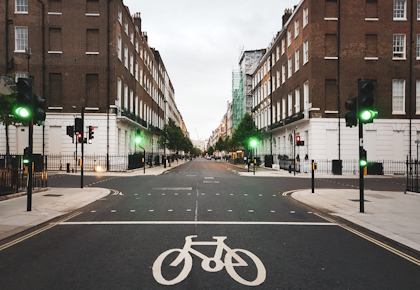GCI Blog
Empowering Communities: 4 Strategies to Increase Cycling to Work
Cycling to work shines as a persistent beacon of hope in the quest for a more sustainable and healthy lifestyle. Cycling to work is a great way to reduce carbon emissions, save money on fuel costs whilst also staying fit. It is unarguably beneficial for both individuals and the environment. However, the numbers are still low – in 2021, only 2% of all trips in England were made by bike. So, the question remains: How can we, as a society, encourage more of us to replace our cars with bikes?
Commuting is one of the inevitabilities of daily life for many people. This makes it a prime area to target when it comes to changing people’s transport habits. Governments, local authorities and individuals need to work together to increase the number of people commuting by bike. Here are some successful strategies that have real potential to transform the way we travel to work.
Bike to Work Schemes
Bike-to-work schemes have been around for several decades now. They were set up to promote healthier commutes and reduce air pollution and have, over the years, helped more than 2 million commuters working for over 40 000 employers get access to a bike. Investing in a bicycle can be an issue, especially with the current cost of living crisis. However, it is also a surmountable problem with the help of bike schemes like Green Commute Initiative, which make it easier for individuals to get a bicycle, including an e-bike, and the necessary protective accessories.
The bike-to-work schemes work so well because they allow people to get a bike and the accessories without having to pay a lump sum upfront. Schemes help spread payments over a long period, 12-18 months usually, without incurring any interest allowing employees to ease the financial burden of buying something pricey.
Cycling Storage Facilities
Installing safe, convenient and accessible bike storage facilities allows employers to encourage more employees to cycle to work. In one of the most recent British Council for Offices office occupier surveys, 22% of respondents said that secure covered bicycle parking/storage would encourage them to cycle to the office. Recognising this need, employers can play a crucial role by investing in good quality, accessible cycling storage on their premises. However, employers truly committed to making their bike-to-work strategy work should remember that installing bike racks and cycle shelters is only the first step. Cyclists and non-cyclists considering biking to work are also worried about issues like arriving sweaty at the office, having a place to leave the extra baggage they may carry around and emergencies like flat tyres. It is worth thinking about how to design the best possible bike-to-work facilities by including extras like showers, lockers and access to pumps and tools in emergencies.
In doing so, employers demonstrate their commitment to sustainable commuting and empower employees with peace of mind and the assurance that their bicycles will be secure and protected. This can do wonders to foster a cycling culture in the workplace. Ensuring the necessary facilities are in place will lay the foundation for a thriving cycling community and inspire more employees to start thinking about cycling as a realistic and obtainable mode of transportation.
Cycling Infrastructure
Cycling has become broadly accepted and supported in the wider political decision-making circles. Its benefits to people and the planet are easy to see and hard to deny. This has led to a much-needed increase in efforts across the UK to improve cycling infrastructure like bike lanes, bike parking and storage spaces.
In 2020, the government published the Gear Change: a bold vision for Cycling and Walking paper, outlining its plans for making streets safer, more cycling and pedestrian-friendly. In the paper, there is also a lot about expanding existing bike lanes, building more bike storage, widening pavement, lowering speed limits across cities and establishing cycle-only lanes in traffic.
These improvements would no doubt be wonderful to see, and it would be a great way to encourage more people to feel safe riding their bikes to work.
Improved Road Safety

It isn’t a surprise that in most surveys, worry about safety in traffic is almost always the top reason people quote when asked why they don’t cycle more. Peddling on a bike surrounded by fast-moving heavy vehicles can be challenging. In 2022, new changes to the Highway Code came into force to make roads safer for cyclists and pedestrians.
The updated rules introduced the idea of a Hierarchy of Road Users and a respective hierarchy of responsibility, prioritising the safety of the more vulnerable road users. The idea is that the person operating a vehicle with a bigger potential to cause significant harm bears the greater responsibility for looking out for others. The changes also clarified and simplified rules around junctions without traffic signals to reduce left-hook collisions for cyclists. There was also a change in guidance regarding the often dangerous overtaking of cyclists – drivers are now advised to leave a minimum of 1.5m of space between them and cyclists and even more room if at high speed.
Green Commute Initiative has a free poster for download to help promote safe passing. Drivers are also formally encouraged to do the “Dutch Reach” when opening car doors to limit car-dooring oncoming cyclists.
Improvements like the latest updates of the Highway Code are a great step in the right direction. Still, additional changes need to be encouraged to make roads even safer for non-motorised traffic participants. A combination of strategies is required to empower communities to feel safe and comfortable cycling to work. Building better cycle storage, solving road issues and expanding cycle-to-work schemes are tried and tested ways to encourage more of us to leave our cars at home and hop on a cycle. By embracing these strategies, we can foster a thriving cycling culture, reduce carbon emissions, improve road safety, and create a healthier and more sustainable today and tomorrow for everyone.
This guest blog was provided by Evelin Petkova, a content producer and researcher specialising in active travel and sustainable transport.



